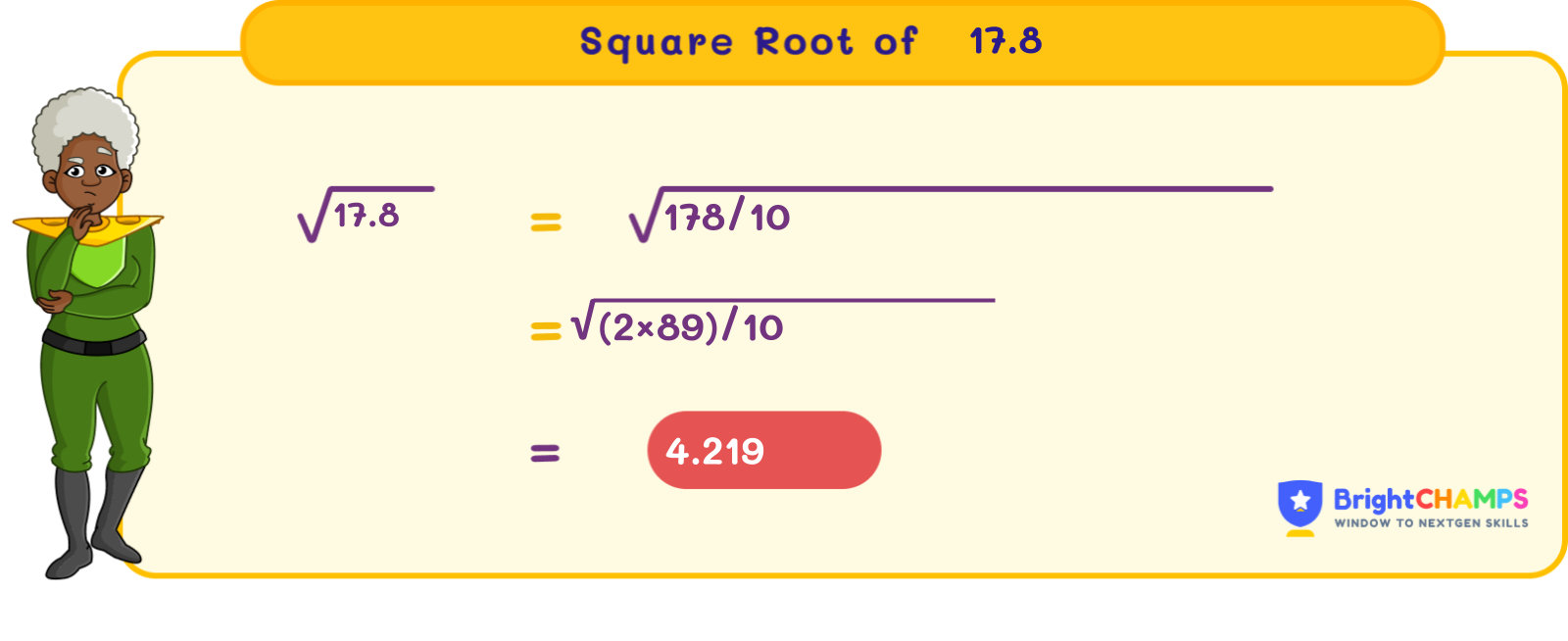![]() Table Of Contents
Table Of Contents

 100 Learners
100 LearnersLast updated on April 8th, 2025

Square Root of 17.8

If a number is multiplied by itself, the result is a square. The inverse of squaring a number is finding its square root. Square roots have applications in various fields, such as engineering, finance, and more. Here, we will discuss the square root of 17.8.
What is the Square Root of 17.8?
The square root is the inverse operation of squaring a number. 17.8 is not a perfect square. The square root of 17.8 can be expressed in both radical and exponential forms. In radical form, it is expressed as √17.8, whereas in exponential form it is (17.8)^(1/2). The square root of 17.8 is approximately 4.21637, which is an irrational number because it cannot be expressed as a simple fraction p/q, where p and q are integers and q ≠ 0.
Finding the Square Root of 17.8
The prime factorization method is suitable for perfect squares. However, for non-perfect squares like 17.8, methods such as the long-division method and approximation method are used. Let us now learn the following methods:
- Prime factorization method
- Long division method
- Approximation method
Square Root of 17.8 by Prime Factorization Method
Prime factorization involves expressing a number as a product of prime numbers. Since 17.8 is not an integer, prime factorization is not applicable directly. Therefore, calculating the square root of 17.8 using prime factorization is not possible.
Square Root of 17.8 by Long Division Method
The long division method is useful for non-perfect square numbers. This method allows us to find the square root more accurately. Here's how to find the square root using the long division method, step by step:
Step 1: Begin by grouping the digits of the number from right to left. For 17.8, we consider it as 1780 (after multiplying by 100 to remove the decimal).
Step 2: Find a number whose square is less than or equal to 17. The number is 4 because 4^2 = 16.
Step 3: Subtract 16 from 17, leaving a remainder of 1. Bring down the next pair, 80, to make it 180.
Step 4: Double the quotient (4), which gives us 8, and use it as the first digit of our new divisor. Find a number n such that 8n × n is less than or equal to 180.
Step 5: The number n is 2 because 82 × 2 = 164, and subtracting 164 from 180 gives a remainder of 16.
Step 6: Add a decimal point to the quotient and bring down 00, making it 1600.
Step 7: The next divisor is 84n, find n such that 84n × n is less than or equal to 1600.
Step 8: Continue this process until you achieve the desired precision.
The square root of 17.8 is approximately 4.21637.
Square Root of 17.8 by Approximation Method
The approximation method is a straightforward way to estimate the square root of a given number.
Step 1: Identify two perfect squares between which 17.8 falls.
The closest perfect squares are 16 and 25.
Thus, √17.8 is between 4 and 5.
Step 2: Apply the approximation formula:
(Given number - smaller perfect square) / (Larger perfect square - smaller perfect square).
Using this formula: (17.8 - 16) / (25 - 16) = 1.8 / 9 = 0.2
Step 3: Add the smaller square root (4) to the decimal value obtained: 4 + 0.2 = 4.2.
So, the approximate square root of 17.8 is 4.2.

Common Mistakes and How to Avoid Them in the Square Root of 17.8

Square Root of 17.8 Examples

Problem 1
Can you help Max find the area of a square box if its side length is given as √17.8?

Explanation

Problem 2
A square-shaped building measuring 17.8 square feet is built; if each of the sides is √17.8, what will be the square feet of half of the building?

Explanation

Problem 3
Calculate √17.8 × 5.

Explanation

Problem 4
What will be the square root of (9 + 8.8)?

Explanation

Problem 5
Find the perimeter of the rectangle if its length ‘l’ is √17.8 units and the width ‘w’ is 5 units.

Explanation


FAQ on Square Root of 17.8
1.What is √17.8 in its simplest form?
2.Is 17.8 a perfect square?
3.Calculate the square of 17.8.
4.Is 17.8 a prime number?
5.What are the factors of 17.8?
Important Glossaries for the Square Root of 17.8
- Square root: A square root of a number is a value that, when multiplied by itself, gives the original number. For example, √16 = 4.
- Irrational number: An irrational number cannot be represented as a simple fraction. It has non-repeating, non-terminating decimal expansions. Example: √17.8 is irrational.
- Decimal: A decimal is a number that has a whole number part and a fractional part separated by a decimal point, such as 4.21637.
- Long division method: A method used to find square roots of non-perfect squares by systematically dividing and averaging.
- Perfect square: A perfect square is a number that is the square of an integer, like 16, which is 4^2.
Explore More algebra
 Previous to Square Root of 17.8
Previous to Square Root of 17.8


Jaskaran Singh Saluja
About the Author
Jaskaran Singh Saluja is a math wizard with nearly three years of experience as a math teacher. His expertise is in algebra, so he can make algebra classes interesting by turning tricky equations into simple puzzles.

Fun Fact
: He loves to play the quiz with kids through algebra to make kids love it.




